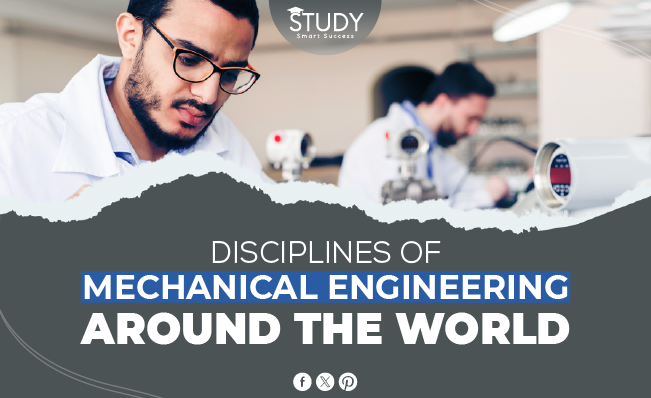Introduction
Mechanical engineering has several fields suitable for interested minds and ambitious engineers. Engineering students, mechanical engineers, and STEM enthusiasts may benefit from understanding these subjects to pursue careers and study more. This blog article covers many areas of mechanical engineering, offering ideas, examples, and critical information for anybody interested in this dynamic discipline.
The Core of Mechanical Engineering
Mechanical engineering is the oldest and most general type of engineering. It involves planning, analyzing, building, and fixing mechanical systems. Mechanical engineers develop new ideas and create tools that change the world, from cars to robots.
Thermodynamics
This field of study looks at how heat and energy change over time. Energy is changed and used in many different ways. This is the main goal of this area. Mechanical engineers use thermodynamics to make engines and cooling systems that work well.
Fluid Mechanics
Fluid mechanics is the study of fluids—such as liquids and gases—along with the forces operating on them. Creating hydraulic systems, pipes, and even elements of cars that enable more seamless movement depends on this field. Understanding fluid behavior helps engineers create systems that fit different purposes.
Materials Science
Items and how they work are studied in materials science. Choosing the right material for the job requires mechanical engineers to know how different materials act in different scenarios. These details are crucial for creating durable and useful items, ranging from spacecraft parts to everyday home items.
Solid Mechanics
Solid mechanics is the study of how things that are solid respond to different events and forces. People in this field help engineers make buildings and tools that can handle stress and pressure. Buildings, roads, and machines are safe and effective based on solid mechanics ideas.
Control Systems
Control systems engineering plans and oversees systems with changing inputs to stabilize results. Robotics and industrial systems need this field a lot. Understanding control systems can help engineers make technologies that work well and respond quickly.
Robotics
Combining mechanical engineering, electrical engineering, and computer science, robotics is Working in robotics. Mechanical engineers design and develop robots capable of doing tasks requiring little human assistance. Robotics may be applied for many purposes, from manufacturing to enabling individuals to explore and have fun.
Mechatronics
Mechatronics is the discipline of mechanical, electrical, and computer engineering applied to intelligent system creation. This field is about creating bright products and systems with information sensing, processing, and acting capabilities. Examples are high-tech medical equipment, autonomous industrial systems, and smart home devices.
Biomechanics
Biomechanics is mechanical engineering that is applied in biology. This field develops medical tools, prostheses, implants, and human mechanics. Through biomechanics, engineers can advance the quality of life and healthcare.
Acoustics
Sound and movements are studied in acoustics. Acoustic mechanical engineers make systems that block out noise, make sound better, and create audio tools. Acoustics is a very important part of making homes and offices that are comfortable and work well.
Automotive Engineering
Automotive engineering is the study of building, designing, and manufacturing automobiles. This area covers a lot of ground, from building safety systems to engines to researching airflow. Mechanical engineers in automotive engineering try to create safe, efficient, and reasonably priced vehicles.
Aerospace Engineering
Aerospace engineering is the study of plane and spaceship construction. You should be familiar with airflow, power systems, and structural physics. In aerospace engineering, mechanical engineers assist in creating innovative technology that can be applied to space flight and aircraft.
Manufacturing Engineering
Manufacturing engineering mostly serves to plan and enhance production strategies. This industry also entails developing effective manufacturing methods, improving product quality, and cutting costs. Mechanical engineers create fresh approaches to address challenges in many spheres of manufacturing engineering.
Energy Systems
The discipline of energy systems engineering creates and runs systems for manufacturing, distribution, and energy usage. High-quality energy solutions—including green energy and energy-efficient technologies—rely on this field. Mechanical specialists working in energy systems assist in tackling global energy-related issues.
Nanotechnology
At the atomic and molecular levels, nanotechnology allows one to alter objects. This field can be applied to create better goods, medicinal treatments, and electrical appliances. Mechanical engineers in nanotechnology try to generate fresh concepts that will transform several companies.
Renewable Energy
Sun, wind, and hydroelectricity, among other renewable resources, are used in renewable energy. Mechanical engineers maximize hydroelectric dams, wind turbines, and solar panels to create renewable energy. Fighting fossil fuel use and climate change depends on this field.
Advanced Computational Techniques
Simulations and advanced computational models help to address difficult technical problems. Mechanical engineers can use FEA and CFD to project system behavior in many contexts. These techniques improve performance, time for development, and product design.
Sustainable Engineering
Solutions developed by sustainable engineering lower environmental impact and increase social benefits and efficiency. These mechanical engineers produce waste reduction, energy economy, and green technologies. Sustainable engineering methods depend on this field to be ensured.
Additive Manufacturing
Additive manufacturing, sometimes called three-dimensional printing, creates layer-by-layer objects from computer models. This approach lets mechanical engineers design complex, customized components that are difficult to produce with conventional techniques. Fast prototyping and less waste from additive manufacturing are transforming sectors.
Marine Engineering
Marine engineering is the study of planning, building, and keeping ships and other watercraft. To work in this area, you must know about fluid physics, materials science, and structural engineering. Marine mechanical engineers plan and build offshore platforms, propulsion systems, and hulls so that maritime activities are safe and run smoothly.
HVAC Systems
Buildings need HVAC systems to ensure the air inside is clean and comfortable. Mechanical engineers make these systems work better so that they use less energy and control the climate. HVAC engineering affects the health and productivity of people in homes, companies, and industries.
Micro-Electro-Mechanical Systems (MEMS)
MEMS, which stands for micromechanical and electrical systems, can be used in medical and consumer electronics. As part of their job, mechanical engineers design and build tiny sensors, actuators, and other parts that make small packages more useful. MEMS technology is needed for smart and small systems.
Conclusion
Mechanical engineering has several fields, each with its difficulties and possibilities. Engineering students, mechanical engineers, and STEM enthusiasts may learn and influence their careers by investigating these fields.
Mechanical engineering offers opportunities to build efficient engines, innovative medical gadgets, and sustainable energy solutions. Join professional groups, attend conferences, and talk to experts to learn more. Explore mechanical engineering’s immense potential and follow your passion!


